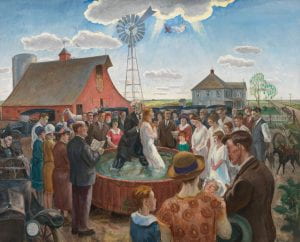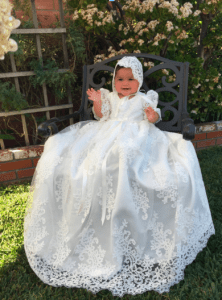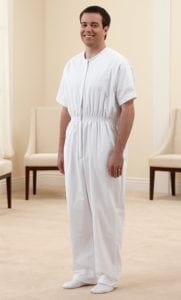Baptismal robes are white garments worn by individuals during a baptism ceremony. These ceremonies can carry multiple meaning across the different religions as can the garments themselves, but overall signifies the spiritual cleansing of one’s sins. The robes are white in color to signify the purity of the individual’s soul and the transformation from being burdened with sin, to being free of sin. The robe modeled above, was borrowed from Two Rivers Baptist Church in King George, Virginia. Two Rivers Baptist Church purchased the robe from Baptismalrobes.net. It is made of polyester-poplin material and has a long zipper that runs from the neck down to the knees, which makes it easy for anyone to step into. There is also a weighted hem to ensure the robe maintains the correct positioning during the ceremony. The robe costs $57 and is a size medium, although there are sizing options ranging from S-XXL. At Two Rivers Baptist Church, the robes were purchased in 2010 and are still currently being used in baptism ceremonies.
Baptism is the ceremonial practice performed in Christianity by the submission and cleansing of a person into water which represents a spiritual cleansing agent. The act of baptizing represents and relays the significance of the resurrection of Christ. This is done for many reasons, including: granting entry of new members into the church, an outward representation of faith, or the last step in achieving salvation into heaven (St. Cyr). An official baptism is performed by either a Priest or someone who has already been baptized. Some religions such as Eastern Orthodox and Roman Catholic, specifically baptize infants, believing we are born into this world with the original sin, while others such as Mormons, Baptists, and Protestants baptize adults, believing we as the individual should make the choice to accept Christ into our lives to remove our sins (St. Cyr).
The first baptisms were performed long ago by followers of the Jewish faith as a customary ritual of purification before the arrival of the Messiah (Blank). The implementation of a Jewish tradition into Christian based religions makes sense once it is realized that Christianity was established later than most religions, so a note-able amount of the original members came from other denominations, bringing traditions and beliefs from all over. As far as the Biblical beginning of baptisms, the Old Testament holds the first traces of the holy act. In 1 Peter 3:2, Peter emphasizes the flood water as a symbol of baptism that saves the people, and prophets of the Old Testament such as Isaiah, Ezekiel, and David all employ water as a token of spiritual cleansing (Hangeraaff). Once baptisms were brought to America, they were usually performed in rivers, lakes, or any large body of water where a person could be fully submerged. Today in America, most baptisms are performed on children or adults by a mode of sprinkling the holy water to cleanse the soul and create a bond with the church. The first baptisms in America included clothes of the simplest kind; white robes, usually handmade by community members.
Lucille Stewart of Louisiana recalls her childhood in the Baptist Church when speaking about baptism robes saying, “I made mine, I made my brothers, and I’ve been thinking… maybe I made my daddy’s when he got baptized, seem like I made his” (Roach).

John Steuart Curry’s painting “Baptism in Kansas” depicts the community involvement of a baptism and the role of baptisms in pop culture
As time went on, children’s baptismal garments got more elaborate, while adult clothing remained simplistic with the continual use of white robes. In more modern times, churches provide the robes for those being baptized, however, most families choose to pick the outfit for small children and babies based on family tradition. Presently, in America, denominations that observe christenings require the infant to be clothed in a christening dress, which contains elaborate lace, beading, and in some cases a pop of color. With denominations that observe baptisms of children and adults, it is required for the individual to be clothed in a full length, long-sleeved white robe that usually zips in the front. The Mormon church is one exception to this style of robe that is used. Mormons are required to wear a white robe that is styled more like a jumpsuit rather than a flowing gown.
Material religion is a part of the religious world that people don’t always pay attention to or get the wrong idea about. It is defined as helping to “bring about religious values, norms, behaviors, and attitudes” (McDannell, 2). It is not about just any object you can go find in a church, but rather about how an object helps define a deeper meaning to a part of that religion or denomination. Baptismal robes are a wonderful example of material religion, as it helps to bring in the values and morals of that religion into baptisms. The ceremony of a baptism not only brings religious material meaning to the robe, but also to water. For instance, the beliefs surrounding baptism activates the water itself by allowing it to represent the spiritual cleansing. The entire ceremony is significant solely due to its spirituality – something that isn’t physical; moreover, the otherwise mundane physical objects involved in the ceremony are delegated their spiritual importance based according to the role they play. Continuing, this delegation of spiritual importance towards the objects has led to the commercialization of religious sectors.
Baptism robes have become a commodity for the churches over the years. It doesn’t take very long to find a place to purchase a baptismal robe online. You can even buy them straight from the churches themselves, like the Mormon suits (store.lds.org). Huggies, the diaper brand, has an informational section included on their website that explains the meaning and importance of a christening dress, yet do not sell them. The website our object was purchased from is a great example of the mixture between commercialism and religion. This mixture can be seen in the way they describe their company, products, and even the way their logo is designed, with a gold cross standing out against black letters. The informal page included about the company states right away “we give thanks to Jesus Christ for He is the One that has blessed us.” (Baptismalrobes.net) They also state they are “glad to be assisting the Kingdom of God with our products.” These statements show that the company is meeting the needs of religious communities since their goal as a business is rooted in their religious beliefs. Baptismal robes have spread outside of the world of religion and into the world of supply and demand.
We would like to thank Two Rivers Baptist Church for allowing us to borrow a baptism robe.
By: Katie Coakley, Tyler Paulovkin, and Sydney Remaily
Bibliography:
“Adult Baptismal Robes.” BaptismalRobes.net,
baptismalrobes.net/product/adult-baptismal-robes/.
Blank, Wayne, “The Origin Of Baptism”, Wayne Blank, accessed March 10, 2018.
http://www.keyway.ca/htm2003/20031106.htm
Baptismal Clothing, The Church of Jesus Christ of Latter-Day Saints,
store.lds.org/webapp/wcs/stores/servlet/Category3_7158395
95_10557_3074457345616706395_-1_N_image_0.
McDannell, C. (1995). Material Christianity. New Haven & London: Yale University Press, p.2.
Hangeraaff, Hank, “Bringing Baptism Into Balance”, April 7, 2009.
http://www.equip.org/article/bringing-baptism-into-balance/
Roach, Susan, “Lucille Stewart: Making Baptismal Gowns” 2012.
http://www.louisianafolklife.org/LT/Articles_Essays/DeltaStewart.html
St. Cyr, Linda. “How Does a Baptism Ceremony Go?” Synonym, 29 Sept. 2017,
classroom.synonym.com/how-does-a-baptism-ceremony-go-12078499.html.
“99 Objects: Sasha Nicholas on Baptism in Kansas by John Steuart Curry.” 99 Objects: Sasha Nicholas on Baptism in Kansas by John Steuart Curry | Whitney Museum of American Art,
whitney.org/Events/99ObjectsBaptismInKansas.


